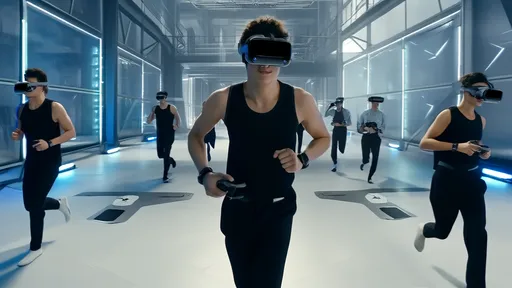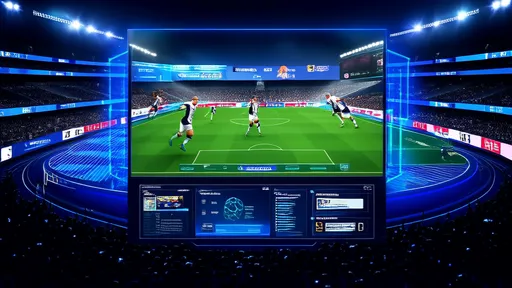The world of virtual reality (VR) gaming is undergoing a transformation, and at the heart of this revolution lies Ultra-Wideband (UWB) technology. Unlike traditional VR setups that rely on optical tracking or infrared sensors, UWB-based positioning systems offer unparalleled precision and scalability, making them ideal for large-scale VR environments. This breakthrough is redefining how players interact with virtual worlds, eliminating the constraints of confined spaces and enabling truly immersive experiences.
Breaking Free from Physical Boundaries
One of the most significant limitations of conventional VR systems has been their reliance on fixed play areas. Players often find themselves confined to small, pre-defined spaces, constantly worrying about bumping into walls or furniture. UWB technology changes this dynamic entirely. By leveraging high-frequency radio waves, UWB tracking systems can precisely locate players within expansive environments, covering areas as large as warehouses or outdoor spaces. This freedom of movement allows game developers to create experiences that were previously unimaginable.
The implications for VR gaming are profound. Imagine exploring vast virtual landscapes without artificial locomotion techniques, where every step you take in the physical world translates seamlessly into the virtual one. Multiplayer experiences reach new levels of authenticity when participants can physically walk around each other, maintaining proper spatial relationships just as they would in real life. This level of immersion was simply unattainable with earlier tracking technologies.
The Technical Edge of UWB
What sets UWB apart from other positioning technologies is its remarkable combination of accuracy, low latency, and resistance to interference. While Bluetooth and Wi-Fi based systems struggle with precision beyond a few meters, UWB can track movements down to centimeter-level accuracy across large spaces. This precision is maintained even in challenging environments with multiple moving objects, making it exceptionally well-suited for dynamic VR applications.
The technology works by measuring the time it takes for radio pulses to travel between anchors (fixed reference points) and tags (worn by players). Unlike signal strength-based approaches that can be affected by environmental factors, UWB's time-of-flight measurements remain reliable regardless of obstacles or interference. This robustness translates to consistent tracking performance that VR systems can depend on for critical gameplay mechanics.
Real-World Applications Taking Shape
Forward-thinking VR arcades and entertainment centers are already adopting UWB-based systems to create unprecedented gaming experiences. One notable implementation involves warehouse-scale zombie survival games where dozens of players navigate through physical sets that mirror their virtual surroundings. The UWB tracking ensures that every crouch behind cover, every tactical retreat, and every coordinated team movement is perfectly captured in the virtual space.
Theme parks are exploring the technology for next-generation attractions that blend physical sets with digital overlays. Visitors wearing VR headsets can interact with both real and virtual elements in perfect synchronization, thanks to UWB's precise positioning. This hybrid approach creates a tangible sense of presence that pure virtual environments often struggle to achieve.
Challenges and Future Developments
Despite its advantages, implementing UWB tracking for large-scale VR isn't without challenges. The initial setup requires careful placement of anchors to ensure complete coverage of the play area, and the system needs proper calibration to maintain accuracy. However, recent advancements in self-configuring anchor networks and machine learning-assisted calibration are making the technology more accessible to venue operators.
Looking ahead, we're seeing exciting developments in power-efficient UWB tags that could enable all-day gameplay without battery concerns. Researchers are also working on integrating haptic feedback systems that respond to the player's precise location within the environment, adding another layer of immersion to the experience.
The convergence of UWB with other emerging technologies like 5G and edge computing promises to further enhance large-scale VR gaming. Real-time environmental processing and cloud-based physics simulations could create persistent virtual worlds that react naturally to players' movements across vast physical spaces. This technological synergy points toward a future where the boundaries between physical and virtual realities become increasingly blurred.
Redefining Social VR Experiences
UWB's impact extends beyond gameplay mechanics into the social dimension of VR. In traditional VR setups, players often appear as floating avatars with limited physical presence. With precise full-body tracking across large spaces, users can interact with much greater nuance and expression. Subtle gestures, spatial relationships, and natural movement patterns all contribute to more authentic social interactions in virtual environments.
This capability opens up new possibilities for VR applications beyond gaming, including virtual meetings, training simulations, and collaborative design spaces. When participants can move and interact as they would in physical spaces, the virtual experience gains an unprecedented level of naturalism that could accelerate adoption across multiple industries.
The Road Ahead for UWB in VR
As the technology matures, we can expect to see standardization efforts that make UWB tracking systems more interoperable and cost-effective. The VR industry is particularly excited about the potential for hybrid tracking solutions that combine UWB with other technologies to create robust, multi-layered positioning systems. Such systems could maintain millimeter-level accuracy while being resilient to any single point of failure.
Consumer adoption will likely follow the commercial implementations, with home VR systems eventually incorporating UWB tracking for room-scale and beyond experiences. As the supporting ecosystem grows, including more developers creating content specifically designed for large-space VR, we're looking at a fundamental shift in how virtual reality gaming is conceived and experienced.
The marriage of UWB technology with VR gaming represents more than just a technical improvement—it's a paradigm shift that unlocks new creative possibilities for game designers and delivers unprecedented immersion for players. As this technology continues to evolve, it promises to redefine our expectations of what virtual reality can be, transforming not just how we play games, but how we interact with digital worlds altogether.

By /Jul 29, 2025

By /Jul 29, 2025

By /Jul 29, 2025

By /Jul 29, 2025

By /Jul 29, 2025

By /Jul 29, 2025

By /Jul 29, 2025

By /Jul 29, 2025

By /Jul 29, 2025

By /Jul 29, 2025

By /Jul 29, 2025

By /Jul 29, 2025

By /Jul 29, 2025

By /Jul 29, 2025

By /Jul 29, 2025

By /Jul 29, 2025

By /Jul 29, 2025

By /Jul 29, 2025